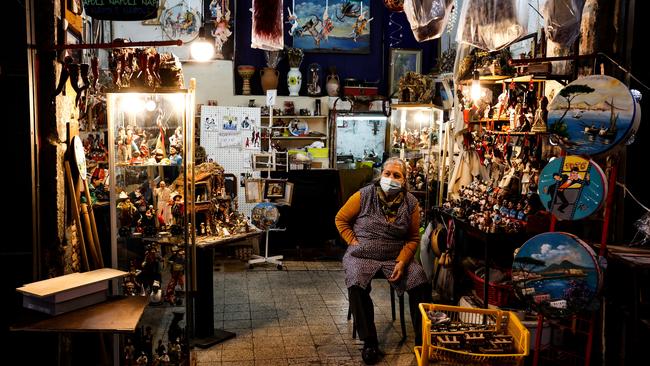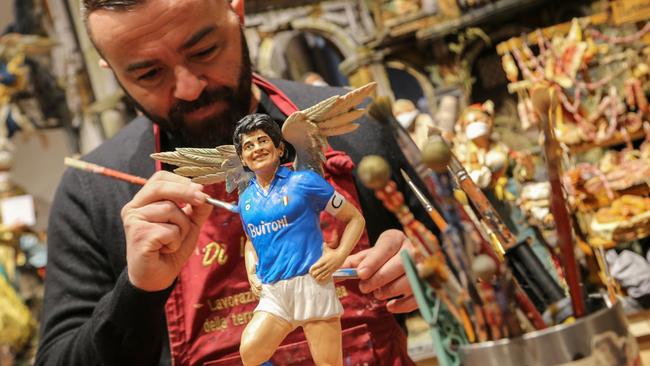For one prized Italian tradition, COVID-19 deals a heartbreaking blow
Artisans clustered along a Naples street have been crafting Nativity scenes for more than a century. But coronavirus restrictions and a dearth of tourists are threatening their survival.

For generations, the Christmas season has brought throngs of visitors to Via San Gregorio Armeno, a historic street in the heart of Naples where artisans have made the city’s famous handcrafted Nativity scenes since the 1800s.
In the run-up to the holiday, the narrow street usually becomes a kaleidoscope of colours, languages and elaborate figurines that mix religious references with modern-day touches.
This year, Via San Gregorio Armeno is largely deserted, with just a trickle of shoppers browsing the scores of stalls.
“It’s heartbreaking to see the street in this condition,” said Lidia Zito, a longtime Neapolitan resident, as she walked by a shuttered store.
Naples’s rich tradition of making Nativity scenes risks falling victim to a pandemic that has dealt an especially brutal blow to Italy’s artisan class and its vast network of family-run shops, some of which have been handed down for generations and are now fighting to survive.
Even among the ranks of Italian handcrafted goods, Neapolitan Nativity scenes have pride of place.
In the 18th century, wealthy Neapolitans commissioned artists to make the scenes, where religious figures made of clay, wood or stone were hand painted and dressed in fine fabrics. They were often set in 18th-century Naples. Today, some sets count dozens of figures and cost thousands of euros.
For many Neapolitans, the Nativity scene, or presepe in Italian, is more the symbol of Christmas than a tree.

The Nativity scene depicts “a miniature utopia, a city that is at peace with itself,” said Marino Niola, an anthropologist at Suor Orsola Benincasa University of Naples. “It is at the core of the Neapolitan idea of Christmas.”
The pandemic, which has hit Naples particularly hard during the northern autumn, has stretched into the two months — November and December — that account for roughly 70 per cent of sales for most artisans.
In mid-November, authorities ordered all non-essential shops in the region to close, including the artisans’ stalls, and they only reopened last weekend.
“We’re running on fumes, and I don’t know for how long we’ll be able to hang on,” said Michele Buonincontro, a craftsman who runs a workshop on Via San Gregorio Armeno.
Many fear the pandemic could kill off this centuries-old tradition or leave enduring scars. Many Italian small businesses lack the financial buffers to see them through hard times.
“The risk that some historic shops may not survive is real,” said Gabriele Casillo, the president of an association representing more than three dozen businesses on the street.
Shops across Naples sell Nativity scenes, but this narrow street is a key piece of the city’s identity. Thanks to its ability to attract tourists from all over the world, it supports a range of businesses.
“If San Gregorio dies, many other businesses in this area will die,” said Andrea Penta, who runs a pizzeria on the street.
The tradition went through a rough patch in the 1970s and 80s, according to Mr Niola, but was able to reinvent itself by adding pop-culture figures to the Nativity scenes.
Diego Maradona, the Argentine soccer star revered for his time playing for the city’s team in the 80s, was among the first modern-day figures to be represented. (Since his death last month, artisans have made new figurines of him, bearing wings.) Over time, the contingent of soccer players, politicians and celebrities displayed on the street has grown steadily.
US presidents have been among the most popular pieces in recent years, said Genny Di Virgilio, whose showroom already features President-elect Joe Biden. Former Italian prime minister Silvio Berlusconi is another favourite among customers.
“Mamma mia! We have sold countless Berlusconis,” Mr Di Virgilio said as he sat at a desk covered with winged Maradona figurines.
New additions usually emerge from national and international events. When the pandemic swept through northern Italy early this year, masked statuettes, depicting both religious figures and frontline workers, began populating the street.
When Vincenzo De Luca, governor of the Campania region that is home to Naples, threatened to send police with flamethrowers to break up rogue parties, statuettes of Mr De Luca armed with a flamethrower quickly ensued.
Now, with sales in some shops down more than 70 per cent this year, many jobs are on the line.
Mr Casillo estimates that an average workshop directly supports four or five families, in addition to a supplier network. High-end statuettes can involve the work of up to a dozen people, according to artisan Marco Ferrigno.

Smaller shops like Mr Buonincontro’s are the most affected. Its annual turnover of around $65,000 is enough to pay costs and sustain the family.
“Making half as much this year would be a miracle,” he said. And with costs approaching $40,000, the artisan is burning through his reserves.
Even bigger names that can count on a strong brand and a larger base of existing customers haven’t been spared. With sales down 75 per cent, Mr Ferrigno, who runs one of the most famous workshops, had to furlough two of his four employees.
“If the situation doesn’t improve, I’ll have to cut some jobs,” he said from a workshop adorned with pictures of popes, celebrities and soccer players holding clay versions of themselves.
Many artisans have tried to boost online sales, but with limited results. People want to see the products, touch and compare them while wandering through the shops in a festive atmosphere, Mr Ferrigno said.
“They want to live the experience of San Gregorio Armeno,” he said. “E-commerce can’t give that.”
The artisans have asked authorities for support such as state grants or suspension of some taxes. After reopening, they are talking with local officials about a way to guarantee safe access to the area. The plan may include checkpoints to limit the number of visitors or a booking system to reserve entry in advance.
By making people feel safe, they hope to save at least December, which is now more important than ever, Mr Buonincontro said.
“I’m an optimist, and I want to believe that we’ll overcome this moment of crisis. However, even an optimist has to come to terms with reality,” he said.
“The coming months will be tough. Really tough.”
The Wall Street Journal







To join the conversation, please log in. Don't have an account? Register
Join the conversation, you are commenting as Logout